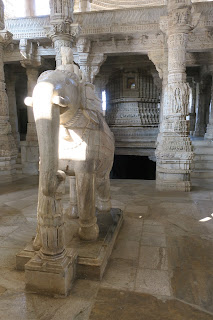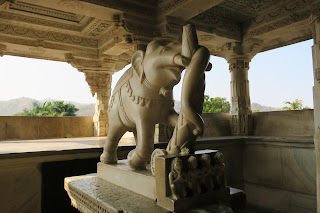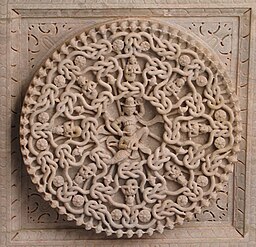Ranakpur Jain temple or Chaturmukha Dharana Vihara is a Śvētāmbara Jain temple
at Ranakpur dedicated to Tirthankara Rishabhanatha. The temple is located in a
village of Ranakpur near Sadri town in the Pali district of Rajasthan.
Darna Shah, a local Jain businessperson, started construction of the temple in
the 15th century following a divine vision. The temple honours Adinath, the
first Tirthankar of the present half-cycle (avasarpini) according to
Jain cosmology. The Ranakpur temple is one of the largest and most important
temples of Jain culture.
Chaturmukha temple is a 15th-century temple dedicated to Adinatha built using
white marble in the midst of a forest. The temple name is credited to its
design of chaumukha with four faces. The construction of the temple and
quadrupled image symbolise the Tirthankara's conquest of the four cardinal
directions and hence the cosmos.
|
Iron gate that gives access to Ranakpur Jain Temple.
|
|
Approaching the temple from the west.
The main facade of the temple faces west, towards the sunset.
|
|
Access to the interior of the temple is via a long staircase.
|
|
Entrance porch (Ardhamandapa).
The Ardhamandapa is the entrance porch forming a transitional area
between the outside and the Pillared hall (Mandapa) of the temple.
-
The Ardhamandapa is usually an open — to provide light and air —
four-pillared pavilion in front of the entrance door of the Pillared
hall (Mandapa) of the temple.
-
See more at
Ardhamandapa - Wikipedia.
|
|
The Amalgamation of Religions at the Entrance.
At the entrance of Ranakpur Temple, you’ll come across a beautiful
doorway decked in carvings.
-
If you look closely, you’ll find the figures of Hindu gods and
goddesses here.
-
Look to the top left of this image and you’ll find the sculpture of
Lord Ganesha from Hinduism.
|
|
Pillared halls (Mandapa).
The four Pillared hall (Meghnad Mandapas) are placed on the four sides
of the holy of holies (Garbhagriha).
-
The Mandapa is a pillared hall for public rituals in Indian
architecture.
-
The Mandapa is a porch-like structure through the (gopuram) (ornate
gateway) and leading to the temple.
-
It is used for religious dancing and music and is part of the basic
temple compound.
-
This prayer hall is generally built in front of the temple's holy of
holies (Garbhagriha).
-
See more at
Mandapa - Wikipedia.
|
|
Marble pillars.
The temple is a grand white marble structure spread over 4,500 m2
(48,000 square feet) with 1444 marble pillars, twenty-nine halls, eighty
domes and 426 columns.
-
The 1444 marble pillars, carved in exquisite detail, support the
temple.
-
The pillars are individually carved and no two pillars are the same.
- Legend says that it is impossible to count the pillars.
|
|
Towers (Shikhara).
The roof of the temple has five large towers (shikhars), of which the
largest crown bejewels the central one. Partially visible from ground
level are the multiple domes that crown the four Pillared hall (Meghnad
Mandapas) that are placed on the four sides of the holy of holies
(Garbhagriha).
-
Shikhara, a Sanskrit word translating literally to "mountain peak",
refers to the rising tower in the Hindu temple architecture of North
India.
Shikhara, a Sanskrit word translating literally to "mountain peak",
refers to the rising tower in the Hindu temple architecture of North
India.
-
A Shikhara over the Garbhagriha chamber where the presiding deity is
enshrined is the most prominent and visible part of a Hindu temple of
North India.
-
See more at
Shikhara - Wikipedia.
|
|
Statue of Ratna Shah.
Small statue of Ratna Shah, brother of Shreshti Dharna Shah, who
completed the temple after his brother’s demise.
|
|
Mata Marudevi.
In front of the incomplete pillar is a huge ornate statue of an elephant
carrying Marudevi, mother of Bhagwan Adinath.
-
In the Svetambara sect of Jain religion, it is believed that when
Bhagwan Rishabhdev attained Kevalgyan, Marudevi visited him on an
elephant along with his grandson Bharat.
-
The sight of enlightened Lord Rishabhdev destroyed all her karmas. She
died at that very moment and attained Moksha; thus becoming the first
human being to attain Moksha in present life-cycle even before bhagwan
Rishabhdev himself. This statue immortalize the incident.
|
|
Another statue of elephant with Marudevi.
Marudevi was the mother of the first Jain Tirthankara, Rishabhanatha and
the queen of King Nabhi.
-
The enlivening of the embryo through the descent of the future
Tīrthankara's soul in the mortal body is celebrated as Garbha
Kalyanaka. At this time, Queen Marudevi dreamt sixteen auspicious
dreams.
-
After these sixteen dreams she saw a large, beautiful bull entering
her open mouth, indicative of a pious and extraordinary soul entering
her womb.
-
See more at
Marudevi - Wikipedia.
|
|
Another statue of elephant with Marudevi.
|
|
Bhagwan Adinatha and the Rayan Tree.
There is a four hundred year old Rayan tree (Manilkara hexandra), under
which are the pagalia (idol of Bhagwan's footprint) of Lord Adinatha.
-
Rayan is an evergreen tree native to India, which is used for many
medicinal purposes in Ayurveda. It is believed that Bhagwan Adinatha
gave his first sermon under a Rayan tree.
-
Rishabhanatha is also known as Adinatha which translates into "First
(Adi) Lord (natha)"
|
|
Another Rayan Tree.
This is one of the 400 year old Rayan trees in the premises of the
Ranakpur Jain temple, dedicated to Adinatha (Rishabhanatha). This is one
of the many sacred trees in Jainism.
-
Rishabhanatha is the first Supreme preacher (Tirthankara) of Jainism.
-
Rishabhanatha was supposed to have given his first sermon under a
Rayan tree.
-
See more at
Rishabhanatha - Wikipedia.
|
|
Sculpture of Lord Krishna.
There are four circular medallions in the temple. All of them compete
with each other in the intricate work done over them and the symbolism
they carry.
-
On one of them Lord Krishna is sculpted, dancing over the entangled
coils of intertwined Kalia-Nag.
-
In Jain religion Lord Krishna is revered as Vasudeva; Vasudevas are
responsible for eliminating evil and in the process they end up
committing a lot of violence.
-
In Jainism they are considered a notch below the Tirthankara because
of this violence.
|
|
Carving of Jambudvipa.
The Jain depiction of the terrestrial world with holy Mount Meru at the
center.
-
According to Jain cosmology, Jambudvipa is at the centre of
Madhyaloka, or the middle part of the universe, where the humans
reside.
-
Mount Meru is at the centre of the world surrounded by Jambudvipa, in
form of a circle.
-
Jambudvipa continent has 6 mountains, dividing the continent into 9
zones (Kshetra).
-
See more at
Jambudvīpa In Jainism - Wikipedia.
|
|
Sculpture of Parshvanatha.
Sahasrafana Parshvanatha sculpture, carved from a single block of
marble.
-
This sculpture depicts the 23rd Tirthankara Parshvanatha in Kayotsarga
pose flanked by the guardian deities Padmavati and Dharnendra.
-
The hood of the 1008 headed mythical serpent Sahasrafana forms a
protective umbrella over Bhagavan Parshvanatha, the intertwined tail
of the serpent is so intricately carved that it is impossible to trace
the end.
-
Parshvanatha is the first Tirthankar for whom there is a historical
evidence.
-
He was the one who established the “four-fold restraint” for his
followers, which is a set of four vows that prevent them from killing,
stealing, lying and owning property.
|
|
Nandishwardvipa plaque.
The Nandishwardvipa plaque has fifty-two shrines erected around the main
shrine.
-
«Fifty-two is the number of temples that emerges naturally from the
strict mirror or the bilateral symmetry of the temples on both the
horizontal and vertical axes. In each of the four clusters of the
temples, located in four cardinal directions, a central temple is
surrounded by four temple in the cardinal directions. Each of these
four is then flanked by two more temples, for a thirteen temples in
each cluster and fifty-two overall.»
-
«In the Jain iconology there is an understanding that perfection is
highly ordered, and therefore any depiction of that which is perfect
must embody a high order of symmetry. Symmetry best conveys visually a
concept of an unchanging perfection that underlies the universe.»
Framing the Jina: Narratives of Icons and Idols in Jain History
by John Cort.
|
|
Apsara Statue.
An Apsara is a member of a class of celestial beings. They are
originally a type of female spirit of the clouds and waters, who later
plays the role of a "nymph" or "fairy".
-
They figure prominently in the sculpture, dance, literature and
painting of many Indian and Southeast Asian cultures.
-
See more at
Apsara - Wikipedia.
|
|
Outer walls of the temple.
|
|
Leaving Ranakpur Jain Temple.
|
|
Monkeys on the side of the road.
|
See also
Source
Location
Fateh Niwas Hotel
Gangaur Ghat
Jagdish Temple
City Palace Udaipur
Raaj Bagh Restaurant
Fateh Sagar Lake
Sahasra Bahu Temples














































